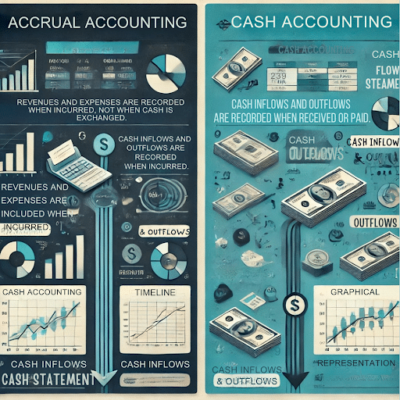Accrual vs. Cash Accounting and the Power of the Cash Flow Statement – Week #41 of The Financial Operating System®

As you get more and more control over your financial reporting and analysis, a key accounting principle you’ll need to address is the difference between Accrual vs. Cash Accounting. Chapter 26 discusses the difference, stresses the importance of choosing the right accounting method for managing business performance, and the insights provided by the cash flow statement.
Key Concepts
1. Accrual Accounting
- Definition: Revenue and expense are recorded when goods and services are delivered or consumed, not when cash changes hands.
- Advantages:
- Better financial insight: Accrual accounting reflects the true economic performance of a business by aligning revenue and expenses with the time period in which underlying business activity occurs (ie, delivering or consuming goods and services).
- Improved financial management: Enables better decision-making by showing the actual economic activity in a period of time, not just cash flow timing.
- Balance sheet and cash flow insights: Includes accounts receivable, accounts payable, prepaid expenses, deferred revenue, and payroll liabilities, providing a full picture of assets and liabilities and drivers of cash flow.
- Drawbacks:
- Requires accounting skill and cost to implement and maintain
- Use Cases:
- Preferred by growing businesses, lenders, and investors.
- Often required by larger organizations or those seeking acquisition, as it aligns with Generally Accepted Accounting Principles (GAAP).
2. Cash Accounting
- Definition: Revenue is recorded when cash is received, and expenses are recorded when cash is paid.
- Advantages:
- Simpler and easier to manage for small startups or businesses with limited accounting expertise.
- Often used for tax purposes to minimize taxable income (e.g., deferring cash receipts or accelerating expenses at year-end).
- Drawbacks:
- Does not reflect the true economic activity of a business in a given period.
- Can create misleading financial reports, especially when customer or vendor payments are advanced or delayed.
- Ignores important balance sheet accounts, such as accounts receivable or payables.
- The cash flow statement does not paint the full picture of what is driving cash flow in and out of the business.
3. Comparing Accrual vs. Cash Accounting
- Accrual Accounting provides a clearer picture of profitability by matching revenues and expenses to time periods matching underlying economic activity.
Cash Accounting, while simpler, can lead to inaccurate perceptions of financial health, particularly when cash flow timing doesn’t align with operating activity.
The Power of the Cash Flow Statement
The chapter highlights the Cash Flow Statement as a vital tool for understanding the movement of cash in a business, especially when using accrual accounting.
Structure of the Cash Flow Statement
- Operating Activities:
- Reflects cash generated or consumed by the business’s core operations.
- Adjusts net income for changes in working capital accounts (e.g., accounts receivable, accounts payable, inventory).
- Key indicator of whether a business is generating enough cash to sustain itself.
- Investing Activities:
- Captures cash flows related to purchases or sales of long-term assets, acquisitions, or other investments.
- Typically sporadic and discretionary.
- Financing Activities:
- Includes cash inflows and outflows from borrowing, debt repayment, owner distributions, or issuing equity.
- Reflects how the business is funded and how much cash is being returned to stakeholders.
Benefits of Accrual Accounting with a Cash Flow Statement
- Accrual accounting captures the economic reality of operations, while the cash flow statement explains what is causing cash in the bank to differ from what is reported in the P&L.
- For example:
- A business may show strong profits under accrual accounting but struggle with cash flow due to delayed customer payments.
- The cash flow statement explains this discrepancy and highlights potential cash management challenges.
Real-World Example
A law firm wanted to keep using cash-basis accounting. However, by switching to accrual-basis accounting and utilizing the cash flow statement:
- The firm gained insights into the volume of services delivered (reflected in monthly client billings, not when clients happened to pay).
- They could align monthly revenue with operating expenses and better manage profitability.
- The cash flow statement helped track the impact of loan repayments and owner distributions that do not appear on the income statement (P&L).
Challenges with QuickBooks
- QuickBooks provides an “accrual” option, but it is misleading because it doesn’t handle true accrual practices for revenue and expense recognition and only looks at the date of invoices and bills.
- The “cash” option in QuickBooks is usually inaccurate due to how QuickBooks compiles cash basis reports.
- Businesses might mistakenly believe they’re using accrual accounting when, in reality, QuickBooks doesn’t automate these functions.
Recommendations
-
Adopt Basic Accrual Accounting:
- Even small businesses should strive to use basic accrual accounting to better understand profitability and align financial reporting with real-world operations.
- Full GAAP compliance is not necessary for most small businesses. Instead, adopt “Management Accrual Accounting” (outlined in Chapter 27) to get 80% of the benefits of GAAP for 20% of the cost.
-
Use the Cash Flow Statement:
- Review accrual-basis income statements alongside cash flow statements to gain a complete financial picture of how cash is coming in and our of your business.
Takeaway:
Using basic accrual accounting combined with looking at the cash flow statement equips you with the tools to understand true profitability and manage cash effectively. While cash accounting may be simpler and cheaper, the resulting financial reports are less useful in understanding financial performance and managing the business.
Next Step:
Business owners can self-implement The Financial Operating System. Chapters are available to download at smartbooks.com/resources or you can buy the whole book from Amazon (the marketing firm version or the general business version).
If you would like assistance with implementation or would like to accelerate results for your business, please contact author Cal Wilder at cwilder@smartbooks.com or book a free consultation with our team directly using this calendar link.